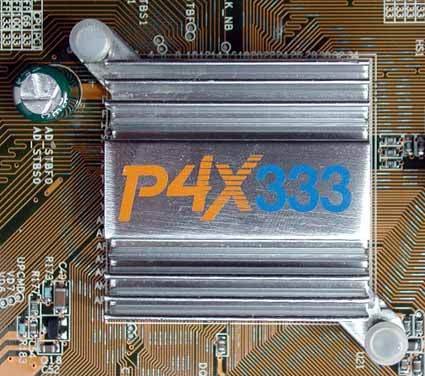Bandwidth For The Masses! VIA P4X333 with DDR333 and AGP 8x
VIA Vs. Intel: A Quick Summary
A first look at the Northbridge, cooled by a small heat sink.
VIA is dipping its toes into a market that has always been dominated by the chip giant Intel. Intel's advantage is that it supplies chipsets for their own processors, thus offering a plattform that is both fast and reliable.
The only setback that Intel ever had to suffer was the disaster with the Pentium III chipset 'i820' and the so-called 'Memory Translator Hub' (or MTH), which was supposed to enable the use of conventional SDRAM memory on a chipset that was designed for Rambus DRAM. Unfortunately, this MTH chip had some bugs that could not been eliminated, and this whole affair was dubbed 'Caminogate' - an allusion to the code-name that was used for i820.
As a result of this disaster, Intel phased out the 820 chipset and released the 815 in order to replace the aged BX. A modified version of this chipset (815T) is used today for Celeron and Pentium III CPUs, but through Intel's mistake, VIA finally gained a strong hold in the market by providing the Apollo Pro 133A chipset which, due to the failure of i820 + MTH, managed to become the fastest PIII chipset at the time.
Since then, products from the Taiwanese company are steadily improving in terms of consistency and performance. Today, VIA is strong enough to push their own technological developments (such as the C3, Eden and now, the first chipset with AGP 8x).
Other Competitors: SiS
However, there is also another competitor that is not dormant - Silicon Integrated Systems (SiS), who has managed to get rid of its "very-low-cost" image within the last months. The first product to surprise us was the 735 chipset for Athlon; today, SiS delivers various chipsets for all of the common PC architectures. The 645DX is their current flagship for the Pentium 4, also supporting DDR333 and 533 MHz FSB, but it lacks support for ATA/133, USB 2.0 and AGP 8x.
While VIA is still fighting for the Pentium 4 bus license, SiS is officially allowed to sell P4 chipsets. This issue could decide whether the P4X333 will be successful or not. In Europe, for example, it's not quite as easy to get motherboards based on the P4X266A (except for the VIA brands), so it looks like the big motherboard players are still cautious.
Get Tom's Hardware's best news and in-depth reviews, straight to your inbox.
Current page: VIA Vs. Intel: A Quick Summary
Prev Page USB, AGP 8x, DDR333, ATA/133: The Perfect P4 Chipset? Next Page Ready For Graphics: AGP 8x Support
Patrick Schmid was the editor-in-chief for Tom's Hardware from 2005 to 2006. He wrote numerous articles on a wide range of hardware topics, including storage, CPUs, and system builds.
